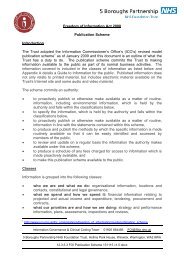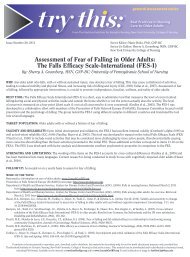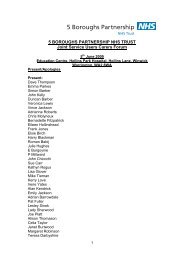5 Boroughs Partnership NHS Foundation Trust Annual ... - Monitor
5 Boroughs Partnership NHS Foundation Trust Annual ... - Monitor
5 Boroughs Partnership NHS Foundation Trust Annual ... - Monitor
Create successful ePaper yourself
Turn your PDF publications into a flip-book with our unique Google optimized e-Paper software.
A series of briefings alerts and newsletters that aim to ensure learning is<br />
shared are distributed throughout the <strong>Trust</strong> regularly. Learning is further<br />
shared in the form of annual conferences such as the Service User and Carer<br />
Involvement Conference, Service User Physical Health and Well-Being<br />
Conference and the <strong>Trust</strong>’s Patient Safety Conference.<br />
4. The Risk and Control Framework<br />
Risk Management Policy<br />
The overall aim of risk management is to ensure that high-quality healthcare<br />
services are delivered with the safety, health and well-being of services users,<br />
carers and staff at the forefront of everything we do and to provide assurance<br />
through clear reporting structures that the risk management system across<br />
the <strong>Trust</strong> is embedded and effective.<br />
The <strong>Trust</strong> is committed to ensuring the safety of service users, staff and the<br />
public through an integrated approach to managing risk whether financial,<br />
organisational or clinical, within systems that are open and transparent and<br />
demonstrate sound governance.<br />
Risk Management Process<br />
In pursuit of implementing effective risk management the <strong>Trust</strong> Risk<br />
Management Policy has adopted the overarching process for managing all<br />
risk within a single framework. The Risk Management Policy details the<br />
framework for identification, evaluation, analysis, treatment, control,<br />
monitoring and review of risks within a single <strong>Trust</strong>-wide Risk Register.<br />
Knowsley Community Provider Services were integrated into the <strong>Trust</strong>-wide<br />
Risk Register on the transfer of services - ensuring that a single system of risk<br />
management was in place.<br />
The risk management process begins with the identification of risks<br />
throughout the <strong>Trust</strong>. Risks are identified through a number of sources<br />
including risk assessment, audit, incidents, complaints, safety alerts, external<br />
reviews and inspection, emerging financial and environmental risks and<br />
compliance with statutory and regulatory requirements.<br />
Risks are evaluated and prioritised using a qualitative approach where the risk<br />
levels, (Consequence and Likelihood) are estimated. This provides an<br />
estimate of where the most serious overall risks lie and assists both the<br />
evaluation and prioritisation of risks within the management decision-making<br />
process.<br />
The Risk Management Policy clearly describes the process for authority to<br />
manage risk within the <strong>Trust</strong> with low-level risk being managed locally and<br />
high-level risk escalated to the <strong>Trust</strong> Management Team and reported to the<br />
<strong>Trust</strong> Board. The <strong>Trust</strong> Board receives bi-monthly reports on the current<br />
status and management of all risks within the <strong>Trust</strong>.<br />
158<br />
<strong>Annual</strong> Report and <strong>Annual</strong> Accounts 2011-12








